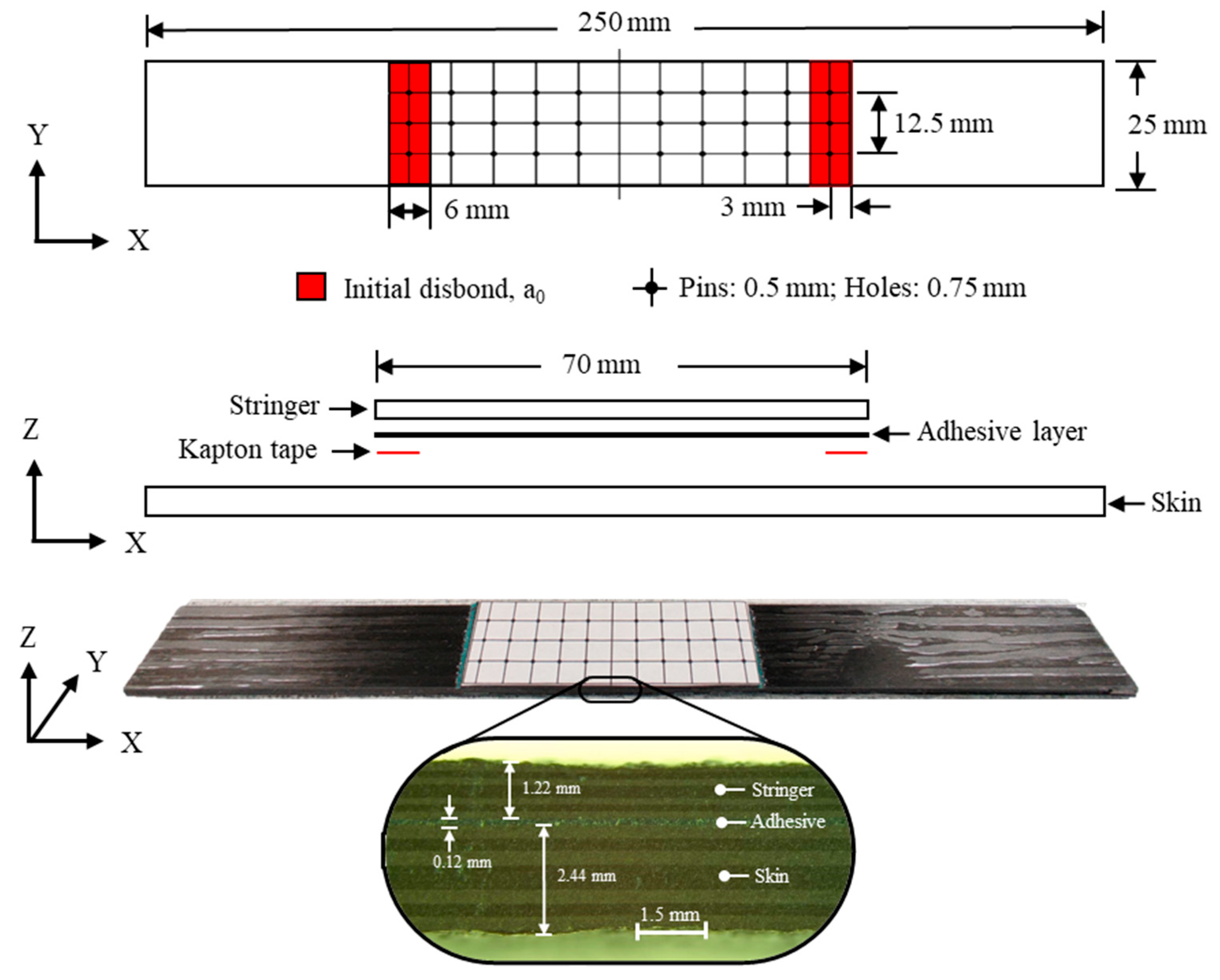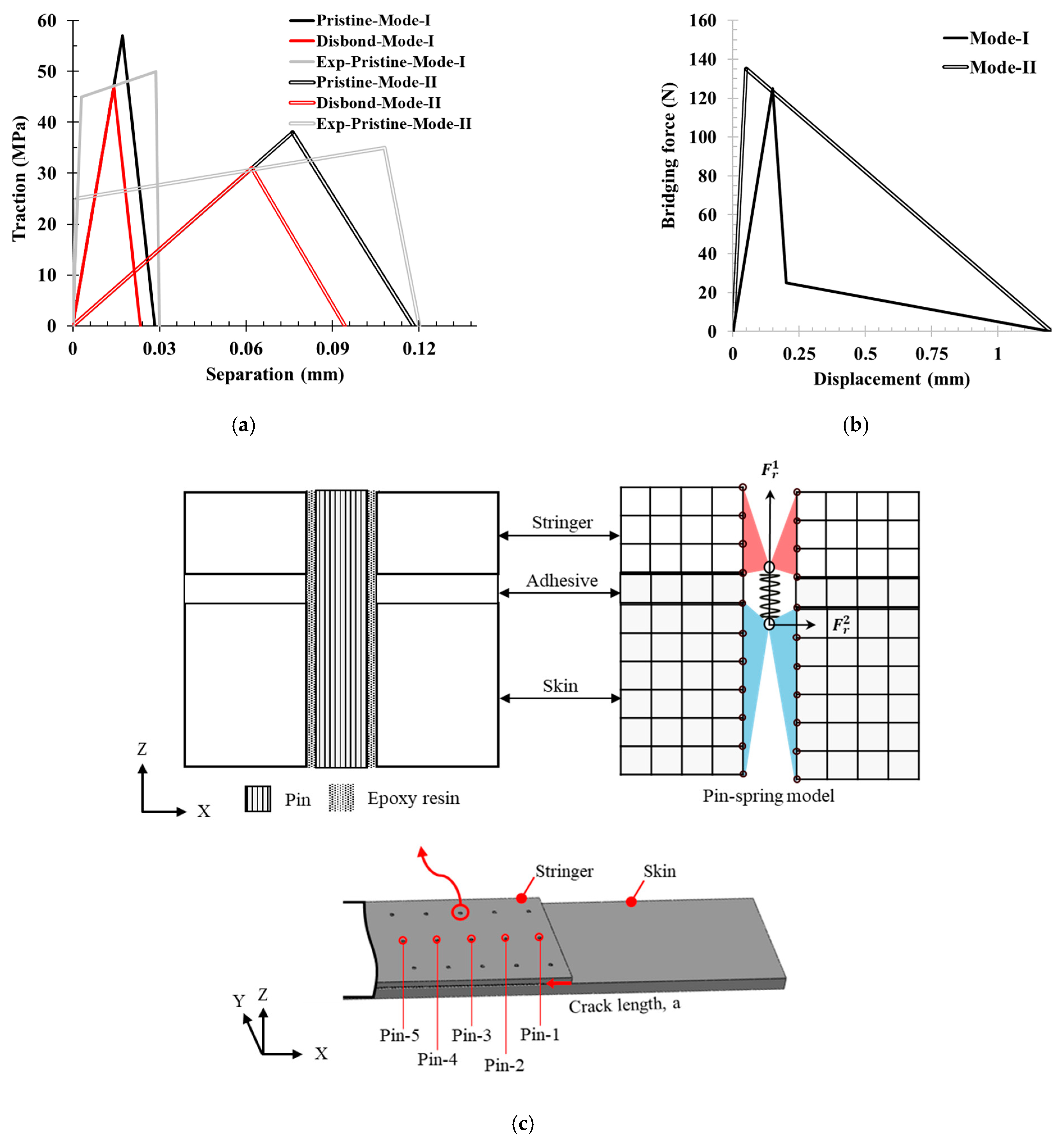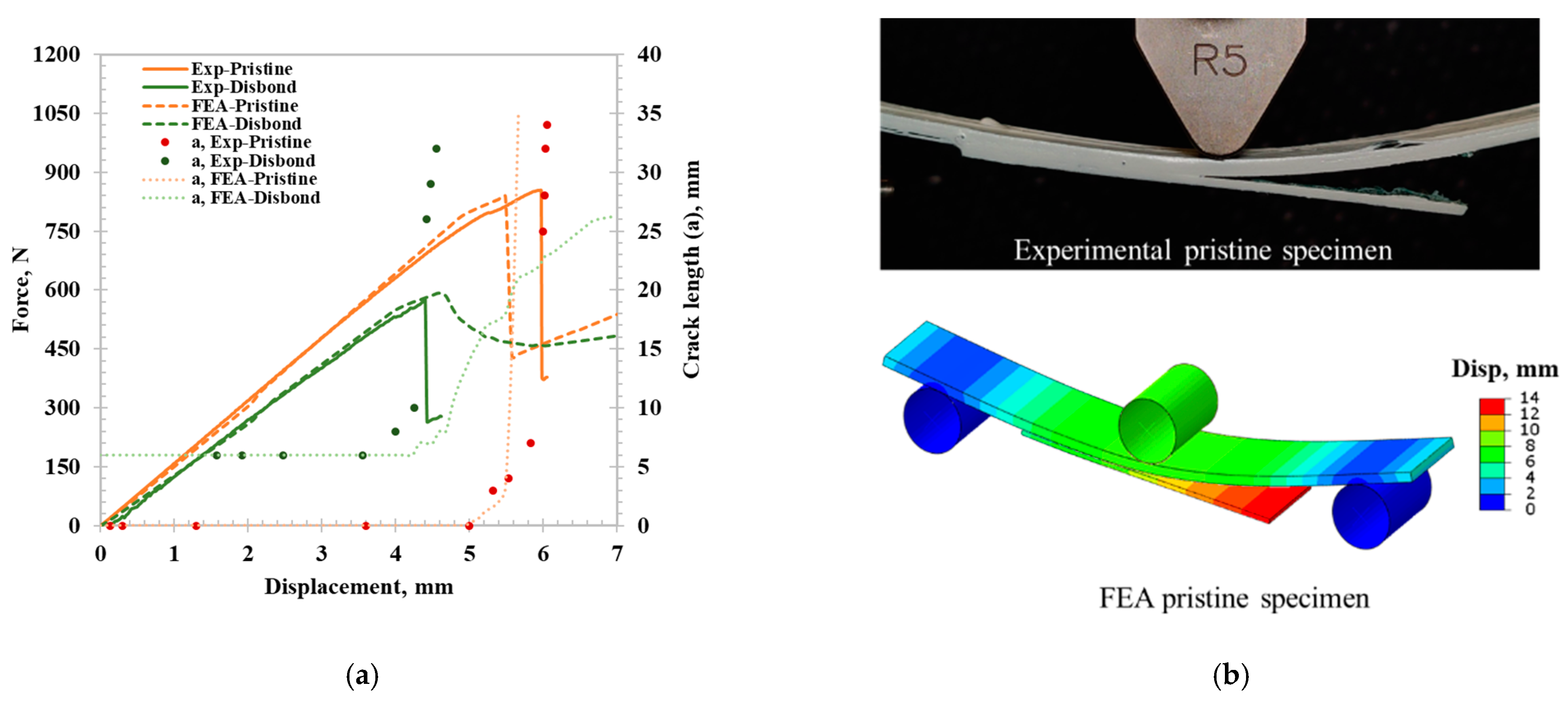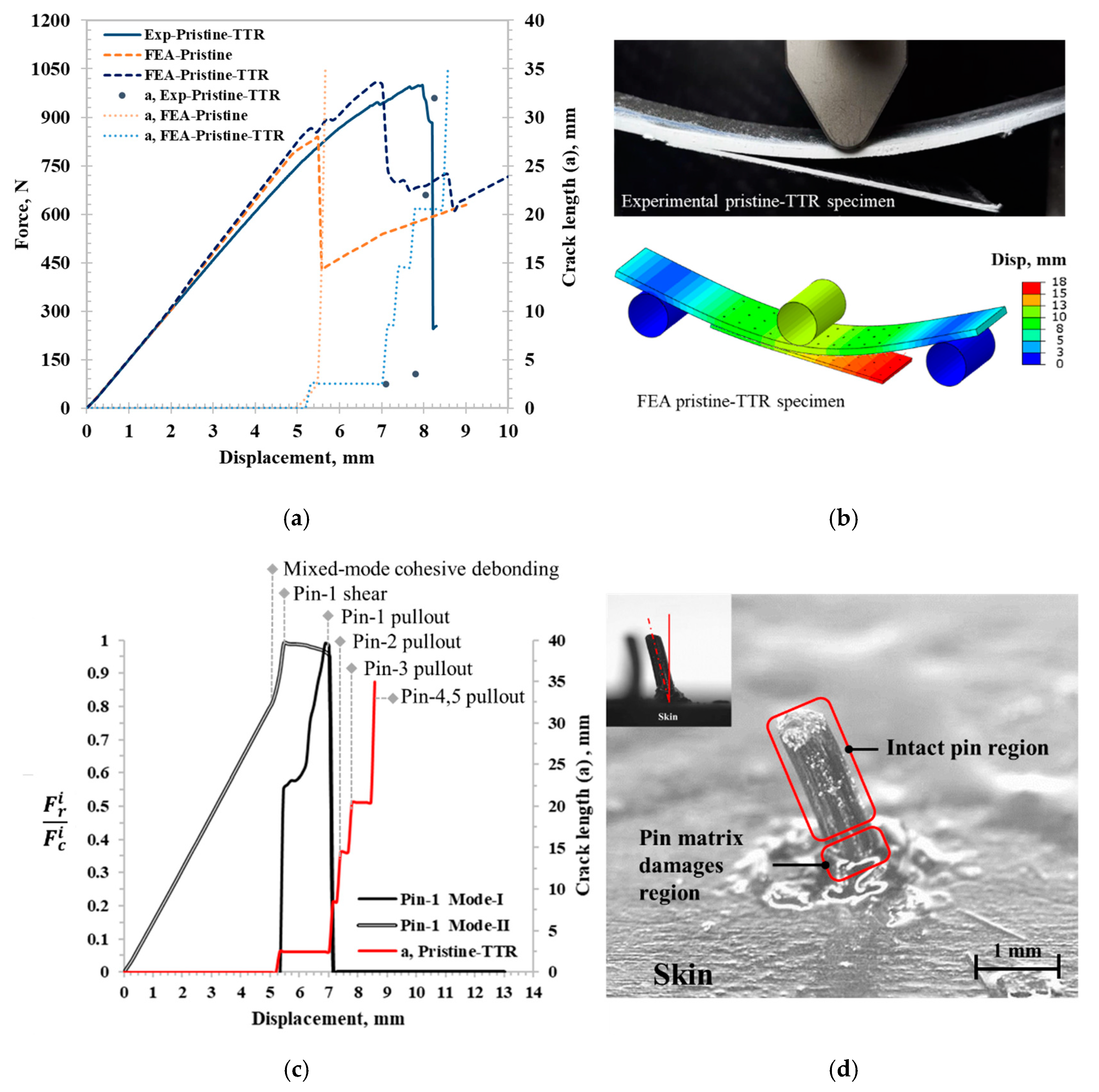Effect of Post-Cured through Thickness Reinforcement on Disbonding Behavior in Skin–Stringer Configuration
Abstract
:1. Introduction
2. Skin–Stringer Specimen Fabrication and Mechanical Test
2.1. Skin–Stringer Specimen Fabrication
2.2. Mechanical Testing
3. FEA Modeling Strategy
3.1. Pin Representation Based on Non-Linear Spring Model
3.2. Cohesive Zone Modeling (CZM) of Skin–Stringer Interface
3.3. Representation of PTTR Using Discrete Pin–Spring Model in Skin–Stringer Configuration
3.4. CZM Validation
4. PTTR Skin–Stringer Disbonding Analysis
5. Conclusions
Author Contributions
Funding
Institutional Review Board Statement
Informed Consent Statement
Data Availability Statement
Conflicts of Interest
References
- Dickson, J.N.; Biggers, S.B. Design and Analysis of a Stiffened Composite Fuselage Panel; NASA Technical Reports Server: Washington, DC, USA, 1980.
- Alhajahmad, A.; Mittelstedt, C. Minimum weight design of curvilinearly grid-stiffened variable-stiffness composite fuselage panels considering buckling and manufacturing constraints. Thin-Walled Struct. 2021, 161, 107526. [Google Scholar] [CrossRef]
- Bhagatji, J.D.; Kravchenko, O.G.; Asundi, S. Mechanics of Pure Bending and Eccentric Buckling in High-Strain Composite Structures. Materials 2024, 17, 796. [Google Scholar] [CrossRef] [PubMed]
- Davies, P. 16-Adhesive bonding of composites. In Adhesive Bonding, 2nd ed.; Adams, R.D., Ed.; Woodhead Publishing Series in Welding and Other Joining Technologies; Woodhead Publishing: Cambridge, UK, 2021; pp. 499–524. [Google Scholar] [CrossRef]
- Mohan, J.; Ivanković, A.; Murphy, N. Mixed-mode fracture toughness of co-cured and secondary bonded composite joints. Eng. Fract. Mech. 2015, 134, 148–167. [Google Scholar] [CrossRef]
- Larson, R.; Bergan, A.; Leone, F.; Kravchenko, O.G. Influence of stochastic adhesive porosity and material variability on failure behavior of adhesively bonded composite sandwich joints. Compos. Struct. 2023, 306, 116608. [Google Scholar] [CrossRef]
- Muc, A.; Romanowicz, P. Effect of notch on static and fatigue performance of multilayered composite structures under tensile loads. Compos. Struct. 2017, 178, 27–36. [Google Scholar] [CrossRef]
- Wan, A.-S.; Xu, Y.; Xiong, J.-J. Notch effect on strength and fatigue life of woven composite laminates. Int. J. Fatigue 2019, 127, 275–290. [Google Scholar] [CrossRef]
- Sendeckyj, G.; Wang, S.; Johnson, W.S.; Stinchcomb, W.; Murthy, P.; Chamis, C. Free-Edge Delamination: Laminate Width and Loading Conditions Effects. J. Compos. Technol. Res. 1989, 11, 15. [Google Scholar] [CrossRef]
- Failure Behavior of Laminated Composite Plates under Anticlastic Bending—Yakup O Alpay, Fatih E Oz, Fazil O Sonmez, Kenan Cinar. 2023. Available online: https://journals.sagepub.com/doi/abs/10.1177/07316844221118633?journalCode=jrpa (accessed on 15 May 2024).
- Goodsell, J.; Pagano, N.J.; Kravchenko, O.; Pipes, R.B. Interlaminar Stresses in Composite Laminates Subjected to Anticlastic Bending Deformation. J. Appl. Mech. 2013, 80, 041020. [Google Scholar] [CrossRef]
- Mou, H.; Xie, J.; Liu, Y.; Cheng, K.; Feng, Z. Impact test and numerical simulation of typical sub-cargo fuselage section of civil aircraft. Aerosp. Sci. Technol. 2020, 107, 106305. [Google Scholar] [CrossRef]
- Raimondo, A.; Riccio, A. Inter-laminar and Intra-laminar damage evolution in composite panels with skin-stringer debonding under compression. Compos. Part B Eng. 2016, 94, 139–151. [Google Scholar] [CrossRef]
- Variyar, A.; Economon, T.D.; Alonso, J.J. Multifidelity Conceptual Design and Optimization of Strut-Braced Wing Aircraft using Physics Based Methods. In Proceedings of the 54th AIAA Aerospace Sciences Meeting, San Diego, CA, USA, 4–8 January 2016; American Institute of Aeronautics and Astronautics: Reston, VA, USA, 2016. [Google Scholar] [CrossRef]
- Ma, Y.; Karpuk, S.; Elham, A. Conceptual design and comparative study of strut-braced wing and twin-fuselage aircraft configurations with ultra-high aspect ratio wings. Aerosp. Sci. Technol. 2022, 121, 107395. [Google Scholar] [CrossRef]
- Kravchenko, O.G.; Kravchenko, S.G.; Sun, C.-T. Thickness dependence of mode I interlaminar fracture toughness in a carbon fiber thermosetting composite. Compos. Struct. 2017, 160, 538–546. [Google Scholar] [CrossRef]
- Dexter, H.B.; Harris, C.E.; Johnston, N.J. Recent Progress in NASA Langley Textile Reinforced Composites Program. September 1992. Available online: https://ntrs.nasa.gov/citations/19950022054 (accessed on 14 April 2024).
- Pegorin, F.; Pingkarawat, K.; Mouritz, A.P. Mixed-mode I/II delamination fatigue strengthening of polymer composites using z-pins. Compos. Part B Eng. 2017, 123, 219–226. [Google Scholar] [CrossRef]
- Chang, P.; Mouritz, A.P.; Cox, B.N. Properties and failure mechanisms of z-pinned laminates in monotonic and cyclic tension. Compos. Part A Appl. Sci. Manuf. 2006, 37, 1501–1513. [Google Scholar] [CrossRef]
- Yudhanto, A.; Lubineau, G.; Ventura, I.A.; Watanabe, N.; Iwahori, Y.; Hoshi, H. Damage characteristics in 3D stitched composites with various stitch parameters under in-plane tension. Compos. Part A Appl. Sci. Manuf. 2015, 71, 17–31. [Google Scholar] [CrossRef]
- Kravchenko, S.; Kravchenko, O.; Wortmann, M.; Pietrek, M.; Horst, P.; Pipes, R.B. Composite toughness enhancement with interlaminar reinforcement. Compos. Part A Appl. Sci. Manuf. 2013, 54, 98–106. [Google Scholar] [CrossRef]
- Pipes, R.B.; Wetherhold, R.C.; Gillespie, J.W. Notched Strength of Composite Materials. J. Compos. Mater. 1979, 13, 148–160. [Google Scholar] [CrossRef]
- Carlsson, L.A.; Adams, D.F.; Pipes, R.B. Experimental Characterization of Advanced Composite Materials, 4th ed.; CRC Press: Boca Raton, FL, USA, 2014. [Google Scholar] [CrossRef]
- Analysis of Open Hole Compression Specimens Using the CompDam Continuum Damage Mechanics Model—NASA Technical Reports Server (NTRS). Available online: https://ntrs.nasa.gov/citations/20205009618 (accessed on 15 May 2024).
- Partridge, I.K.; Yasaee, M.; Allegri, G.; Lander, J.K. 6-Damage-tolerant composite structures by Z-pinning. In Toughening Mechanisms in Composite Materials; Qin, Q., J. Ye, J., Eds.; Woodhead Publishing Series in Composites Science and Engineering; Woodhead Publishing: Cambridge, UK, 2015; pp. 161–189. [Google Scholar] [CrossRef]
- Wang, C.H.; Duong, C.N. Bonded Joints and Repairs to Composite Airframe Structures; Academic Press: Cambridge, MA, USA, 2015. [Google Scholar]
- Kravchenko, S.G.; Kravchenko, O.G.; Carlsson, L.A.; Pipes, R.B. Influence of through-thickness reinforcement aspect ratio on mode I delamination fracture resistance. Compos. Struct. 2015, 125, 13–22. [Google Scholar] [CrossRef]
- Suresh, M.; Sanders, A.; Prajapati, P.; Kaipa, K.; Kravchenko, O.G. Composite sandwich repair using through-thickness reinforcement with robotic hand micro-drilling. Compos. Struct. 2020, 248, 112473. [Google Scholar] [CrossRef]
- Young, R.D.; Rose, C.A. STAGS Developments for Residual Strength Analysis Methods for Metallic Fuselage Structures. Presented at the AIAA/ASME/ASCE/AHS/ASC Structures, Structural Dynamics, and Materials Conference, National Harbor, MD, USA, 13–17 January 2014. Available online: https://ntrs.nasa.gov/citations/20140011911 (accessed on 14 April 2024).
- Cvitkovich, K.; Kevin, T.; Army, U.S. Testing and Analysis of Composite Skin/Stringer Debonding Under Multi-Axial Loading; National Aeronautics and Space Administration, Langley Research Center: Hampton, VA, USA, 1999.
- Mohamed, G.; Allegri, G.; Yasaee, M.; Hallett, S.R. Cohesive element formulation for z-pin delamination bridging in fibre reinforced laminates. Int. J. Solids Struct. 2018, 132–133, 232–244. [Google Scholar] [CrossRef]
- Wanthal, S.; Schaefer, J.; Justusson, B.; Hyder, I.; Engelstad, S.; Rose, C. Verification and Validation Process for Progressive Damage and Failure Analysis Methods in the NASA Advanced Composites Consortium. In Proceedings of the American Society for Composites (ASC) Technical Conference, West Lafayette, IN, USA, 23–25 October 2017; Available online: https://ntrs.nasa.gov/citations/20170010327 (accessed on 15 April 2024).
- Silva, L.F.M.; Marques, E.A.S.; Campilho, R. Design rules and methods to improve joint strength. In Handbook of Adhesion Technology; Spring: Berlin/Heidelberg, Germany, 2018; pp. 773–810. [Google Scholar] [CrossRef]
- Discrete Spring Model for Predicting Delamination Growth in Z-Fiber Reinforced DCB Specimens—NASA Technical Reports Server (NTRS). Available online: https://ntrs.nasa.gov/citations/20040070763 (accessed on 16 April 2024).
- Zhang, B.; Allegri, G.; Yasaee, M.; Hallett, S. Micro-Mechanical Finite Element Analysis of Z-pins under Mixed-Mode Loading. Compos. Part A Appl. Sci. Manuf. 2015, 78, 424–435. [Google Scholar] [CrossRef]
- Bianchi, F.; Zhang, X. Predicting mode-II delamination suppression in z-pinned laminates. Compos. Sci. Technol. 2012, 72, 924–932. [Google Scholar] [CrossRef]
- Bianchi, F.; Zhang, X. A cohesive zone model for predicting delamination suppression in z-pinned laminates. Compos. Sci. Technol. 2011, 71, 1898–1907. [Google Scholar] [CrossRef]
- Mohapatra, P.C. Characterization of Adhesive and Modeling of Nonlinear Stress/Strain Response of Bonded Joints. Ph.D. Thesis, Washington State University, Pullman, WA, USA, 2018. Available online: https://rex.libraries.wsu.edu/esploro/outputs/99900581509601842 (accessed on 22 April 2024).
- Benzeggagh, M.L.; Kenane, M. Measurement of mixed-mode delamination fracture toughness of unidirectional glass/epoxy composites with mixed-mode bending apparatus. Compos. Sci. Technol. 1996, 56, 439–449. [Google Scholar] [CrossRef]
- Song, K.; Aerospace, S.; Space, A.; Va, H.; Dávila, C.G.; Rose, C.A. Guidelines and Parameter Selection for the Simulation of Progressive Delamination. In Proceedings of the 2008 ABAQUS User’s Conference, Newport, RI, USA, 19–22 May 2008. [Google Scholar]
- Blackman, B.; Hadavinia, H.; Kinloch, A.; Williams, J. The use of a cohesive zone model to study the fracture of fibre composites and adhesively-bonded joints. Int. J. Fract. 2003, 119, 25–46. [Google Scholar] [CrossRef]
- Baker, A.A. Composite Materials for Aircraft Structures, 3rd ed.; AIAA Education Series; AIAA: Reston, VA, USA, 2004; Available online: https://arc.aiaa.org/doi/book/10.2514/4.103261 (accessed on 15 May 2024).
- Seneviratne, W.; Saseendran, V.; Shafie, M.; Tomblin, J. Skin/Stringer Interface Damage Characterization of Stiffened Composite Structures. In Proceedings of the American Society for Composites— Thirty-Sixth Technical Conference on Composite Materials, Virtual, 20–22 September 2021; Destech Publications, Inc.: Lancaster, PA, USA, 2021. [Google Scholar] [CrossRef]






| Symbol | Material Constants (Units) | Magnitude |
|---|---|---|
| Skin and stringer laminate engineering constants | ||
| E1 | Longitudinal Young’s modulus (GPa) | 143 |
| E2, E3 | Transverse Young’s modulus (GPa) | 8 |
| v12 | Poisson coefficient | 0.32 |
| G12, G13 | Shear modulus (GPa) | 3.1 |
| G23 | Shear modulus (GPa) | 2.7 |
| Pristine cohesive element properties | ||
| K1 | Normal penalty stiffnesses (N/mm) | 3333 |
| K2, K3 | Shear penalty stiffnesses (N/mm) | 500 |
| Tc | Normal interfacial strength (MPa) | 57 |
| S12, S13 | Shear interfacial strength (MPa) | 38 |
| Energy rate per unit area in normal direction (mJ/mm2) | 0.32 | |
| Energy rate per unit area in shear direction (mJ/mm2) | 0.80 | |
| Experimental | FE Model | |||
|---|---|---|---|---|
| Stiffness (N/mm) | Failure Load (N) | Stiffness (N/mm) | Failure Load (N) | |
| Pristine | 159.25 ± 3.86 | 854.66 ± 13.63 | 166.28 | 839.32 |
| Pristine-TTR | 148.87 ± 4.05 | 987.7 ± 17.40 (15.5% improvement) | 167.40 | 1009.77 |
| Disbond | 136.36 ± 6.52 | 564.47 ± 12.83 | 139.68 | 592.41 |
| Disbond-TTR | 149.66 ± 5.84 | 682.15 ± 39.92 (20.9% improvement) | 145.94 | 810.87 |
Disclaimer/Publisher’s Note: The statements, opinions and data contained in all publications are solely those of the individual author(s) and contributor(s) and not of MDPI and/or the editor(s). MDPI and/or the editor(s) disclaim responsibility for any injury to people or property resulting from any ideas, methods, instructions or products referred to in the content. |
© 2024 by the authors. Licensee MDPI, Basel, Switzerland. This article is an open access article distributed under the terms and conditions of the Creative Commons Attribution (CC BY) license (https://creativecommons.org/licenses/by/4.0/).
Share and Cite
Bhagatji, J.D.; Morris, C.; Sridhar, Y.; Bhattacharjee, B.; Kaipa, K.N.; Kravchenko, O.G. Effect of Post-Cured through Thickness Reinforcement on Disbonding Behavior in Skin–Stringer Configuration. Materials 2024, 17, 3389. https://doi.org/10.3390/ma17143389
Bhagatji JD, Morris C, Sridhar Y, Bhattacharjee B, Kaipa KN, Kravchenko OG. Effect of Post-Cured through Thickness Reinforcement on Disbonding Behavior in Skin–Stringer Configuration. Materials. 2024; 17(14):3389. https://doi.org/10.3390/ma17143389
Chicago/Turabian StyleBhagatji, Jimesh D., Christopher Morris, Yogaraja Sridhar, Bodhisatwa Bhattacharjee, Krishnanand N. Kaipa, and Oleksandr G. Kravchenko. 2024. "Effect of Post-Cured through Thickness Reinforcement on Disbonding Behavior in Skin–Stringer Configuration" Materials 17, no. 14: 3389. https://doi.org/10.3390/ma17143389





